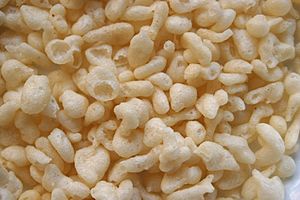Tenkasu facts for kids

Close up of tenkasu.
|
|
| Place of origin | Japan |
|---|---|
| Main ingredients | Batter |
Tenkasu (pronounced ten-KAH-soo) are small, crunchy pieces of fried batter. They are a popular ingredient in Japanese cuisine. People often describe them as "tempura waste" because they are a byproduct of making tempura.
What is Tenkasu?
Tenkasu are made from flour batter that has been deep-fried. They are very crispy and add a nice texture to many dishes. Think of them like crunchy sprinkles for savory foods!
How Tenkasu is Used
These crispy bits are used in many Japanese meals. They are especially popular in noodle dishes.
- Soba and Udon: When added to hot soba or udon noodles, the dish is called tanuki-soba or tanuki-udon. The tenkasu soak up the broth, becoming soft yet still flavorful.
- Takoyaki: Tenkasu are often mixed into the batter for takoyaki. These are round, ball-shaped snacks with octopus inside.
- Okonomiyaki: They are also a common ingredient in okonomiyaki. This is a savory pancake that can include many different ingredients.
Different Names for Tenkasu
Tenkasu has another common name: agedama (pronounced ah-geh-DAH-mah). This name literally means "fried ball."
- In western Japan, people usually say tenkasu.
- In eastern Japan, agedama is more common.
- A survey in 2003 found that most Japanese people (68%) used the name tenkasu. About 29% used agedama.
See also
 In Spanish: Tenkasu para niños
In Spanish: Tenkasu para niños

All content from Kiddle encyclopedia articles (including the article images and facts) can be freely used under Attribution-ShareAlike license, unless stated otherwise. Cite this article:
Tenkasu Facts for Kids. Kiddle Encyclopedia.

